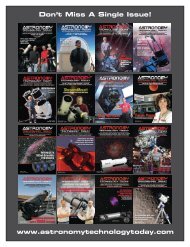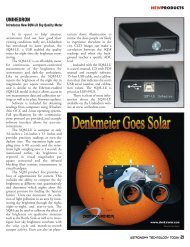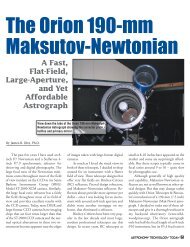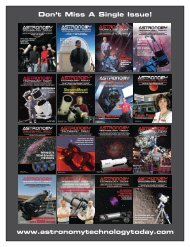magnilux - Astronomy Technology Today
magnilux - Astronomy Technology Today
magnilux - Astronomy Technology Today
Create successful ePaper yourself
Turn your PDF publications into a flip-book with our unique Google optimized e-Paper software.
A 3D CAD<br />
Primer<br />
From Papyrus to 3D<br />
Animation – A Boon for<br />
ATM Enthusiasts!<br />
By Art Bianconi<br />
Some archeologists attribute the<br />
invention of drafting to the Egyptians.<br />
While cave dwellers did rough sketches of<br />
structures on cave walls, the idea of representing<br />
complex geometry with three or<br />
more views was done, some say, in an<br />
attempt to build secret passageways in the<br />
pyramids. Their motive is said to have<br />
been a need to hide access to the burial<br />
chambers of the pharaohs. Others credit<br />
the Egyptians for originating the idea, but<br />
insist that the Greeks really developed it.<br />
Judging from the results, drafting has<br />
been much more successful as a discipline<br />
than efforts by Egyptian architects to hide<br />
the pharaohs’ treasures. To me, what is fascinating<br />
about drafting is that the principles<br />
that drive it continued for so long<br />
without any fundamental change since its<br />
inception around 3200 BC. That’s about<br />
5000 years!<br />
At the heart of this developmental<br />
stagnation is the simple fact that virtually<br />
every example of drafting has been limited<br />
by the two-dimensional surface<br />
defined by paper, another equally-old<br />
medium, also attributed to the Egyptians<br />
(papyrus).<br />
While the advent of the personal<br />
computer in the early 1980s did wonders<br />
for drafting, the design environment was<br />
still limited to a flat surface. Programs like<br />
AutoCAD, VersaCAD, et al, added speed<br />
and accuracy to the techniques of drafting,<br />
but designers were still left with the<br />
same creative dilemma: you would think<br />
of something in three-dimensional space,<br />
but were still forced to translate it, one<br />
line at a time, using multiple views, onto<br />
paper. Then you crossed your fingers and<br />
hoped that a craftsman would translate<br />
the two-dimensional data accurately, and<br />
build it. You also hoped that all the parts<br />
would fit, as designed, with no interference.<br />
Such was the problem of living in a<br />
three dimensional universe, but confined<br />
to expressing ideas in the limited, twodimensional<br />
medium.<br />
<strong>Astronomy</strong> TECHNOLOGY TODAY 57

















